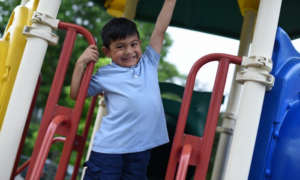
Screenshot from www.aspeninstitute.org.
Aspen Institute Youth Commission member Eric Guercio (far right) speaks at a panel discussion at the Aspen Institute. He is a freshman at Princeton University. At far left is Youth Commission member Grace Dolan-Sandrino, a senior at Duke Ellington School of the Arts in Washington, D.C. Virginia Gov. Terry McAuliffe (center) moderated the discussion.
The Aspen Institute is urging making schools safer by using social and emotional learning principles.
“Safety is about the absence of violence,” but it is also about creating an environment of belonging and trust in which people are valued, said Tim Shriver, co-founder of the Collaborative for Academic, Social, and Emotional Learning (CASEL), who spoke at the Aspen event Friday in Washington, D.C.
“The challenge is serious, immediate, big and urgent,” he said. He pointed to students from Parkland, Florida, who are calling for safety in schools in the wake of the shooting there in February.
The nation’s approach to education has emphasized academic skills and failed to create an environment that fosters social and emotional growth, according to Aspen’s National Commission on Social, Emotional Academic Development.
Grace Dolan-Sandrino, a senior at Duke Ellington School of the Arts in Washington, said that schools are currently focused on grades and SAT scores and lack focus on students as whole people.
“It’s not a holistic process,” she said. Schools are not helping students develop the skills “to have a good life.” She is a member of Aspen’s youth commission.
Students need to have a strong relationship with teachers, Dolan-Sandrino said. They also need to be doing things like presentations and peer evaluations to develop a variety of skills.
When schools are actively “teaching respect and collaboration, these become the morals and values of these students,” she said.
Social and emotional learning generally refers to teaching students to:
- Understand and manage emotions
- Set and achieve positive goals
- Feel and show empathy for others
- Establish and maintain positive relationships and
- Make responsible decisions.
Schools can teach by setting up environments that encourage these ways of being; they can also provide direct instruction or embed instruction into existing academic classes, according to CASEL.
“We know what developmentally supportive environments look like,” said Karen Pittman, co-founder of the Forum for Youth Investment and a panel member at the event. Schools have to ask themselves whether their official practice is going to be metal detectors or youth-led discussions, she said.
Shayne Evans, founder of the Academy Group, which offers academic programming to underserved youth in Chicago, also contrasted the use of metal detectors with the nurturing of human relationships. His school worked to improve safety by building relationships among students, making it easier for students to come talk to adults, he said.
“It was not perfect,” he said, but it’s necessary.
“When will young people of color get the safety to dream?” he asked.































